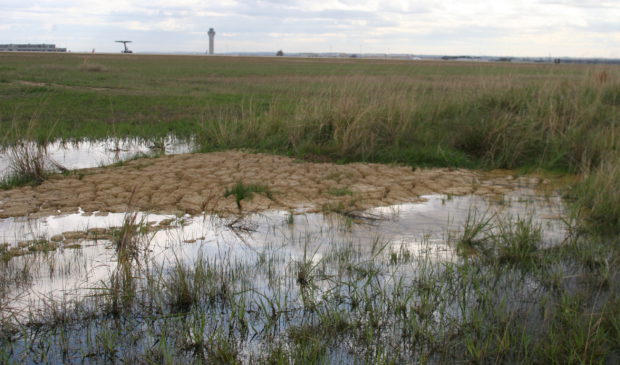Restoration of wetland impacted by airport jet-fuel storage facility construction site leak nearing completion
Tuesday, April 25, 2023 by
Nina Hernandez Work to remediate a non-toxic mud spill on protected wetland near Austin-Bergstrom International Airport will conclude at the end of this month.
The spill occurred in September as crews bored a tunnel underneath the airport runway.
The Environmental Commission reviewed the status of the cleanup during an April 19 update on the construction of the project.
During the presentation, Kane Carpenter, the Department of Aviation’s environmental affairs division manager, addressed the mud release incident and updated commissioners on the remediation process.
The restoration team comprises the airport’s Environmental Affairs and Wildlife Management divisions, the Watershed Protection Department, the Federal Aviation Administration, the U.S. Army Corps of Engineers and the facility developer. So far, the team has completed removal of the mud, which was hauled off-site for proper disposal, and it has excavated, filled and graded the affected areas.
The next step is to plant native wetland plants and seed mix, a process that was delayed because the team’s biologist preferred to wait until the spring. That work should be completed this month.
Carpenter noted that the spill covered just about 0.02 acres of wetland adjacent to the facility site, which is less than 1,000 square feet, and that the combination of mud and water is “really not a hazardous compound” and does not contain any chemicals that would cause harm to the wetland.
There were no impacts to people, Onion Creek or any of the downstream tributaries, according to Carpenter. After the spill, ABIA worked with its regulatory partners, the Watershed Protection Department, the Federal Aviation Administration and the U.S. Army Corps of Engineers on an appropriate restoration plan.
ABIA project manager David Smythe-Macaulay informed the Airport Advisory Commission about the 500-gallon spill in February. Smythe-Macaulay told airport commissioners that the team had installed protective barriers to prevent runoff and the mud had not migrated farther than the initial spill. He noted grass had already begun to grow through the mud.
“Although it’s not completely restored yet, we monitored any runoff or impacts,” Carpenter told the Environmental Commission last week. “We did not see any. The mud just kind of came up to the surface and solidified very quickly. We actually have more water there than we had before.”
Why has the process taken more than six months? Carpenter said the delay in restoration can be attributed to the lengthy federal process required in the event of such a spill. The city needs permission from various federal entities before it can begin. He said Watershed would have preferred a faster timeline, but the airport needed to confirm that it had all the necessary approval from federal agencies before proceeding.
The Austin Monitor’s work is made possible by donations from the community. Though our reporting covers donors from time to time, we are careful to keep business and editorial efforts separate while maintaining transparency. A complete list of donors is available here, and our code of ethics is explained here.
You're a community leader
And we’re honored you look to us for serious, in-depth news. You know a strong community needs local and dedicated watchdog reporting. We’re here for you and that won’t change. Now will you take the powerful next step and support our nonprofit news organization?






